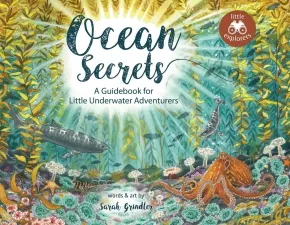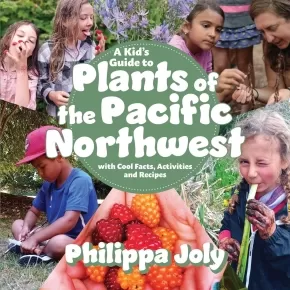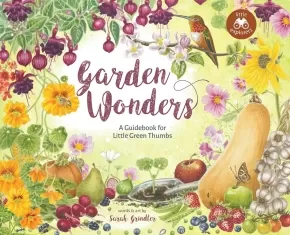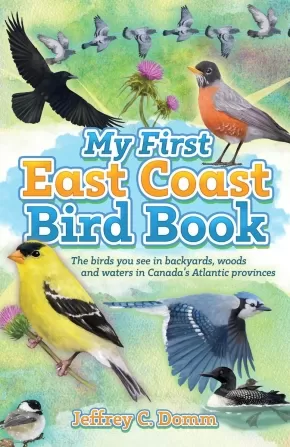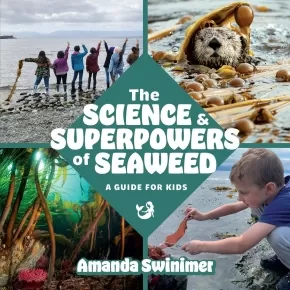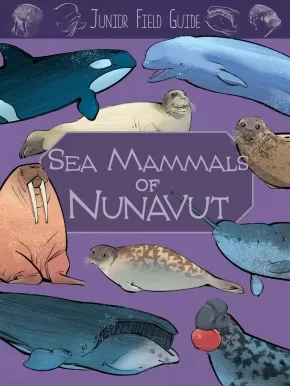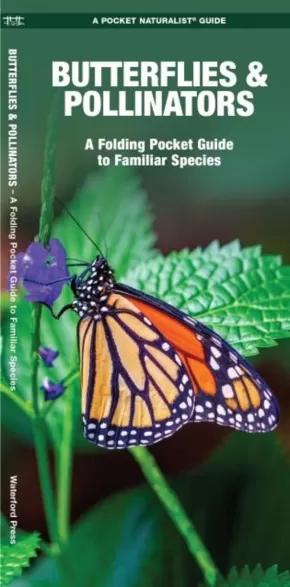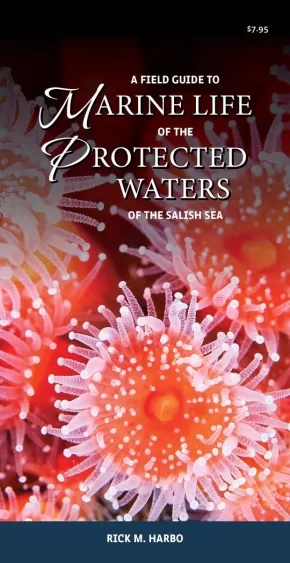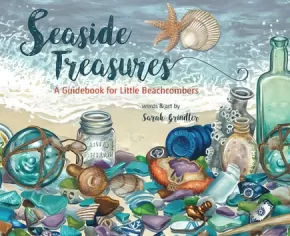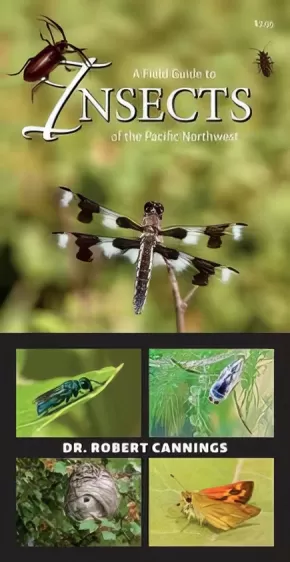Field Guides
Synopsis:
A middle-grade-friendly introduction to flora of the Great Lakes Region, with outdoor activities, games and quizzes that make learning about nature fun! Great for families and educators.
Get dirty digging up roots. Crouch down to look closely at a carnivorous sundew dissolving a dragonfly. Make an elderberry concoction. Test your plant ID skills with a winter twig quiz. Make a soothing plantain salve to treat an itch. Learn which berries you can eat and which to avoid.
Time spent outdoors encourages children’s self-confidence and independence, increases attention span and physical well-being, and fosters care for the environment. With the increasing intrusion of technology into daily life, and the challenges of climate chaos, it has never been more essential for parents and educators to encourage kids to engage with the natural environment. Plants are everywhere, even in urban areas where parks, empty lots and backyards offer the opportunity to learn from and connect to nature.
Drawing on their years of experience as outdoor educators, co-authors Philippa Joly and Danielle Gehl Hagel feature fifty richly illustrated plant profiles, including information on identification and ecology, cultural uses, and fun activities—all in a way that is accessible and interesting to readers of all ages.
Educator Information
Juvenile Nonfiction.
Additional Information
224 pages | 8.50" x 8.50" | Paperback
Synopsis:
The newest book in the Little Explorers series takes young readers from the seashore to the ocean floor, finding fascinating plants and animals and solving ocean mysteries along the way.
Let's meet some of the amazing sea life that calls the ocean home.
What creatures live where there is no sunlight? How do tides work? Is coral a plant or an animal? Search for the answers to these questions and more in the newest book in the Little Explorers series! With engaging text and realistic illustrations, young readers will adventure through the fascinating underwater world of our planet's oceans.
Learn why some sea creatures glow, and how sharks can be as small as a pencil or as long as a bowling lane. From the helpful kelp forests of the shallow sunlight zone to the cold depths of the abyssal zone, interesting plants and animals abound—and many mysteries too.
Let's dive in!
Educator & Series Information
Recommended Ages: 4-8
This book is part of the Little Explorers Series.
Additional Information
32 pages | 8.00" x 6.50" | Hardcover
Synopsis:
A comprehensive guide to Ontario trees.
Featuring more than 1,400 vibrant photographs and illustrations, this visually rich and inviting field guide describes the trees likely to be encountered in Ontario, whether on a hike in the woods or on a walk down city streets.
Covering both naturally occurring and cultivated species, this book features an illustrated glossary of botanical terms, distribution maps, and photographs depicting distinctive characteristics of individual tree species.
With diagnostic descriptions for quick recognition of trees by their component parts, and easy-to-use identification keys covering summer and winter conditions, A Field Guide to Trees of Ontario is a must-have for tree enthusiasts--novices and experts alike.
Carry it with you wherever you may find trees, which is practically everywhere.
Additional Information
512 pages | 4.50" x 8.00" | Paperback
Synopsis:
A middle-grade-friendly introduction to Pacific Northwest flora, with outdoor activities, games and quizzes that make learning about nature fun! Great for families and educators.
Get dirty digging up roots. Crouch down to look closely at a carnivorous sundew dissolving a dragonfly. Munch some lemony-tasting miner’s lettuce. Go on a scavenger hunt for some of nature’s more surprising creations, like the arbutus tree, a sculpture of living copper. Make a soothing plantain salve to treat an itch. Learn which berries you can eat and which to avoid.
Time spent outdoors encourages children’s self-confidence and independence, increases attention span and physical well-being, and fosters care for the environment. With the increasing intrusion of technology into daily life, and the challenges of climate chaos, it has never been more essential for parents and educators to encourage kids to engage with the natural environment. Plants are everywhere, even in urban areas where parks, empty lots and backyards offer the opportunity to learn from and connect to nature.
Drawing on her years of experience as a herbalist and outdoor educator, author Philippa Joly features more than fifty richly illustrated plant profiles, including information on identification and ecology, uses in Coastal Indigenous cultures, and fun activities—all in a way that is accessible and interesting to readers of all ages.
Reviews
“This is an absolutely delightful book, dedicated to helping children and youth build relationships with the plants in their world. It is a rich compendium of plant portraits and descriptions, personal stories, recipes, games and hands-on activities—like making tea from Yerba Buena or making a root-digging stick of Oceanspray. Philippa’s obvious love of kids, plants and the natural world shines through—and it is catching!” — Nancy Turner, Professor Emeritus, University of Victoria, and author of Plants of Haida Gwaii
Educator Information
Recommended for ages 6 to 12.
Table of Contents
1. Indigenous Peoples of the Pacific Northwest Coast
2. Regions and Plants Covered by This Book
3. Plant Names and Language
4. Dos and Dont's of Wildcrafting Plants
5. Understanding Plant Families
6. Plant Guilds
7. Poisonous Plants
8. Invasive Plants
9. Plant Profiles
10. For Parents and Educators
Additional Information
232 pages | 8.50" x 8.50" | Paperback
Synopsis:
Part of the Little Explorers series, this book shows young readers how to garden everything from flowers to veggies — and offers tips and tricks for keeping it all in bloom.
Let's get our hands dirty!
Whether you have a big backyard or pots on a balcony, you can grow just about anything if you have healthy soil, plenty of water, and bright sunlight. This book in the Little Explorers series takes young readers through every step to creating their own garden: from collecting nutrient-rich soil and choosing the right time of day to water your plants, to identifying helpful critters from unwanted pests. Featuring new vocabulary words like "germinate," "fertilizer," and "pollinator," and encouraging a microscopic look at nature, this is the perfect book for curious little gardeners.
What will you grow first?
Educator & Series Information
Recommended Ages: 4-8
This book is part of the Little Explorers Series.
Additional Information
32 pages | 8.00" x 6.50"
Synopsis:
An all-new, richly illustrated easy-to-use guide that with the six identifying features of each of the most common birds on the east coast.
This book makes identifying the most common birds found on the east coast of Canada easy. It includes detailed illustrations of every bird, showcasing their size and colour, flight patterns, dietary habits and other useful facts.
Using this book, kids and novice bird watchers will be able to identify birds you may see in your back yard, on the trails or at the beach, helping them to reconnect with nature and wildlife.
Author and illustrator Jeffrey C. Domm is an expert with over 20 nature guides published. His illustrations go far beyond anything seen in common bird guides with detail and clarity.
More than forty birds are included, from those you will see in your backyard – like the American crow and the Blue Jay – to those you will see while at the beach or walking along a trail, like the Great Blue Heron and the Bald Eagle. Each bird has over ten illustrations for easy and clear identification.
Reviews
"This book is charming...looking closer at the book I noticed the bird images weren’t the generated images I thought they were. They were illustrations. And beautiful ones." — Katy Jean, The Chronicle Herald
Educator Information
Children's Book.
Additional Information
104 pages | 5.51" x 8.50" | Paperback
Synopsis:
A middle-grade and family-friendly introduction to the enchanting world of seaweed.
Young readers will be delighted to learn about the wonderful, watery world of seaweed, where emerald-green kelp forests grow as tall as trees and rainbow seaweeds shimmer like gemstones in the sunlight. Seaweed can be fun too, providing tasty snacks like nori crisps and cool things to do: hunt for dead man’s fingers to squeeze like a squirt gun, have a popping contest with rockweed or make seaweed art. Seaweeds are also critical to the health of the planet—they produce most of the oxygen we need to breathe, help to keep the earth cool and provide habitat for sea creatures. And they're full of healthy vitamins and have more minerals than any other food!
This colourful, activity-packed book explores the science of seaweed while showing how to sustainably harvest and use it, and providing many fun facts about marine plants and animals. It is a unique field guide, featuring seaweeds from both Atlantic and Pacific oceans and showcasing the beautiful and vital ecosystems of the coasts, and is sure to inspire curious beachcombers of all ages.
Educator Information
Recommended for ages 6 to 12.
Additional Information
168 pages | 8.50" x 8.50" | Paperback
Synopsis:
Learn about what kinds of sea mammals live in the Arctic! From narwhals and belugas to walruses and ringed seals, this nonfiction book introduces young readers to wildlife in arctic waters.
An exciting addition to the collection of Junior Field Guides from Inhabit Education Books!
Educator & Series Information
Recommended for ages 8 to 10.
This book is part of the Junior Field Guide series. Perfect for learning all about living things in the Arctic! These Junior Field Guides give information and interesting facts about the different animals that live in Nunavut.
Additional Information
32 pages | 7.50" x 10.00" | Paperback
Synopsis:
A beautifully illustrated, compact, interactive nature guide to exploring the forest for young readers.
What do you notice when you walk in the forest? Different types of trees, plants, and mushrooms? Maybe you hear a squirrel chattering or birds singing. Can you feel all the different kinds of moss? And look there! Hidden animal homes and interesting bugs.
With this compact non-fiction guide, young readers will be equipped to seek out, identify, and appreciate the woodland magic that exists all around them. Featuring rich vocabulary words like "nurse log," "lichen," and "sapling," this beautifully illustrated book is the ideal companion for little forest explorers. Incorporating all five senses and encouraging imaginative play, it even includes pixies and fairies (pixie cup lichen and fairy slipper wildflowers)! Forest Magic will be the book you reach for on the way out the door to explore your own backyard.
There's so much to see in a forest. What will you discover?
Educator & Series Information
Recommended for ages 4 to 8.
This book is part of the Little Explorers Series.
Additional Information
32 pages | 8.00" x 6.50"
Synopsis:
Crabs can be found in abundance along the shorelines from Oregon to BC, burrowed under sand, soil and rocks. Keep this portable field guide handy on trips to the seashore to identify over forty species of crabs and hermit crabs in all shapes and sizes. Discover the differences between the Butterfly Crab and the Puget Sound King Crab and learn how to distinguish between male and female crabs. With full-colour photographs featuring both dorsal and ventral views, and accompanied by descriptive text for easy identification, A Field Guide to Crabs of the Pacific Northwest is an ideal companion for curious beachgoers of all ages.
Additional Information
2 pages | 37.00" x 9.00"
Synopsis:
From dinosaur bones to petrified wood and from primordial seashells to archaic oddballs, this handy field guide makes identification of fossils a cinch. Learn how to identify a fossil and discover the most up-to-date tips on where and when to hunt for them. Featuring gorgeous full-coloured photos and paired with short and informative descriptions, this field guide is suitable for fossil enthusiasts of all ages and skill levels. Lightweight and pocket-sized for convenience, A Field Guide to Fossils is easy to grab and toss into any fossil lover’s backpack on their next adventure.
Additional Information
2 pages | 37.00" x 9.00" | 65 colour photographs | Pamphlet
Synopsis:
Some of the most vibrant colors and patterns in the Animal Kingdom are found among butterflies. Gawdy swallowtails, exquisite gossamer-wings, and a multitude of eye-catching brushfoots are particular standouts, though plenty of whites, sulphurs, metalmarks, and skippers are also adorned with splendid markings. Flowering plants across North America attract some 700 butterfly species as well as thousands of moths, bees, wasps, flies, and beetles, not to mention some hummingbirds and bats. This portable reference is a handy tool for those wishing to deepen their understanding of butterflies and other colorful pollinators. It features beautiful illustrations of 70 familiar butterflies and moths as well as some especially common larvae and pupae. Also included are notes on life cycles and other common pollinators. Laminated for durability, this lightweight, 12-panel folding pocket guide is a terrific resource for educators, learners, naturalists, and gardeners.
Additional Information
12 pages | 4.10" x 8.35"
Synopsis:
A Field Guide to Marine Life of the Protected Waters of the Salish Sea includes the most commonly observed species in the tide pools and protected waters of the Salish Sea—that intricate network of coastal waterways spanning southern BC and northwestern Washington. Covering invertebrates, fish and seaweeds, this guide includes key identification features, fun facts and habitat, as well as seventy colour photographs. Water-resistant and compact, this guide is easy to pack on any trip to the shore and perfect for curious minds of all ages.
Rick Harbo is one of the Pacific Northwest’s leading marine writers and photographers.
Additional Information
2 pages | 37.00" x 9.00" | 75 photographs | Pamphlet
Synopsis:
A day of beachcombing is a day filled with salty sea air, enchanting seashells, and exciting discoveries. The ocean holds so much beauty and adventure, and it leaves so many treasures on its shores. Let's explore these seaside treasures.
An essential sea glass–hunting handbook for kids. With helpful advice, like "make sure no one's home!" before taking a snail shell, and fascinating facts, like how sea glass is formed and where glass fishing floats come from, the gentle and flowing text invites young readers to explore and wonder about everything that washes up on the sand.
Author and illustrator Sarah Grindler's images are vivid and realistic, showing readers what to look for by the ocean—from purple sea urchin shells (that otters love to much on) to mussel shells, sand dollars, and every colour of sea glass—and encouraging all of us to imagine where those treasures may have come from. A beautiful keepsake as well as a practical guidebook for the young beachcomber.
Educator & Series Information
Recommended Ages: 4-8
This book is part of the Little Explorers Series.
Additional Information
32 pages | 8.00" x 6.50"
Synopsis:
Insects are all around us, from the butterflies in our gardens to the mosquitoes in the woods. About 80 percent of the 1.5 million named species of animals on earth are insects. Without flower-loving bees, wasps, flies and beetles, most crops and wild plants would not be pollinated and would disappear.
But insect diversity is largely invisible because most insects are small and difficult to recognize and identify. They are often easy to ignore.
A Field Guide to Insects of the Pacific Northwest is a durable, water-resistant eight-fold field guide that describes more than sixty of the most common species that are likely to be encountered in the many habitats of the Pacific Northwest. Full-colour macro photos of specimens in their natural habitats accompany handy descriptions with information on specific species’ anatomy, identification and importance in the ecosystem. Readers will be fascinated by interesting (and occasionally gruesome) facts about the insect inhabitants of the Pacific Northwest—for instance that the robber fly injects its insect prey with a fluid that dissolves muscles and organs before sucking their prey dry like a milkshake.
The species in A Field Guide to Insects of the Pacific Northwest have been expertly chosen to introduce the diversity of insect life while also being accessible to novice bug enthusiasts. Most species shown are common but not necessarily familiar. The selection represents nineteen major groups, or orders. The largest are Coleoptera (beetles), Diptera (true flies), Hymenoptera (wasps, bees and relatives) and Lepidoptera (moths and butterflies). These groups are broken down into smaller families, such as scarab beetles or sphinx moths.
A Field Guide to Insects of the Pacific Northwest showcases the amazing diversity of insects that the region holds, and will encourage curious readers to learn a little about the main groups of insects and the intriguing details about their lives.
Additional Information
2 pages | 37.00" x 9.00" | 65 Colour Photographs | Pamphlet



